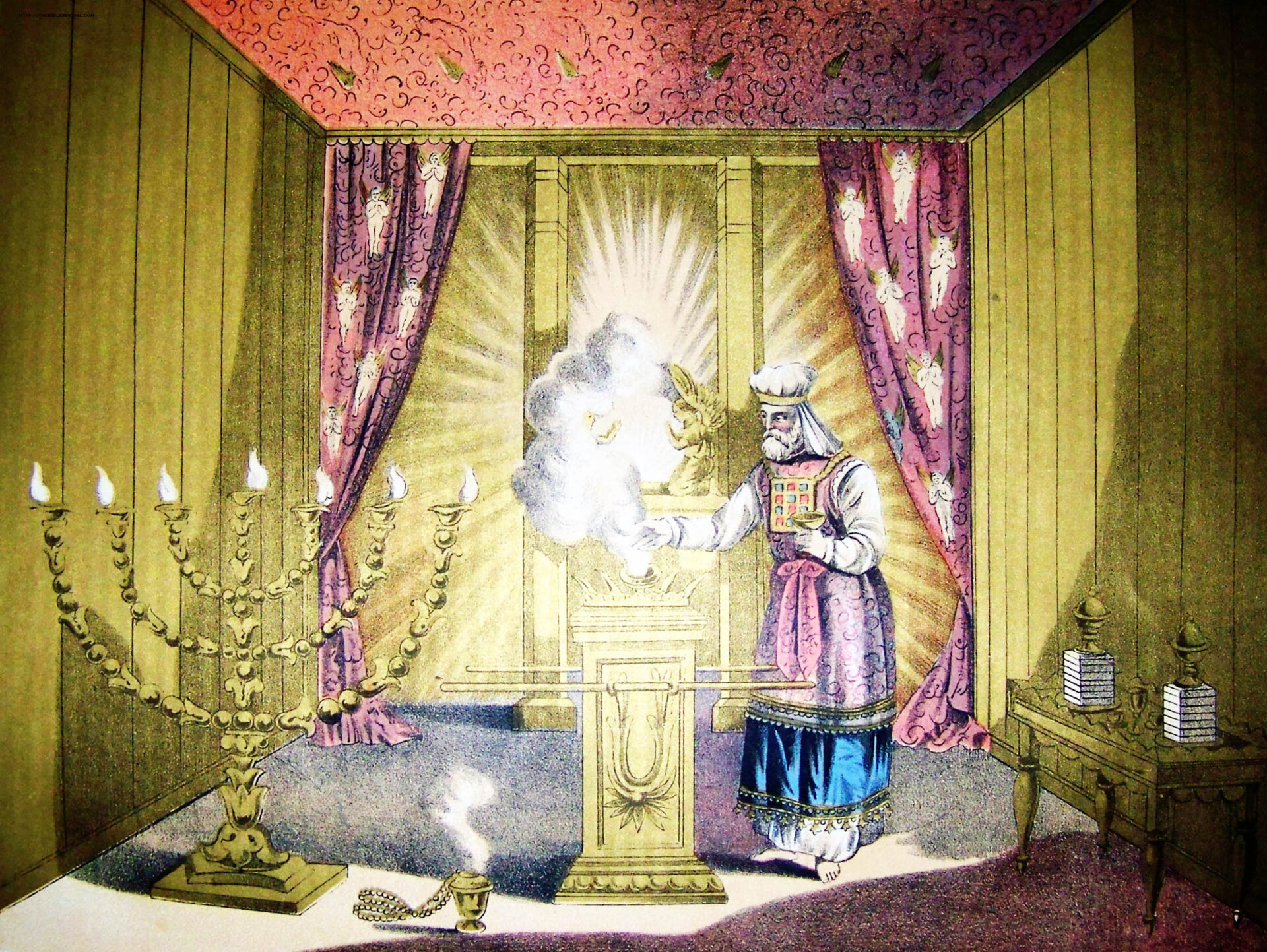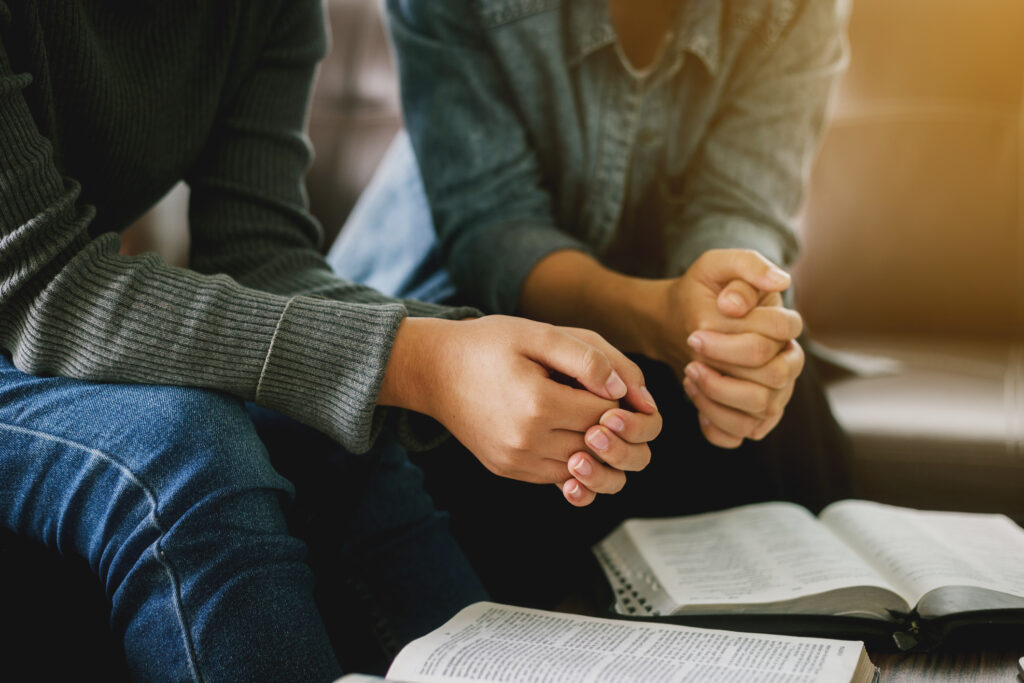Through studying the Tabernacle, its design, and its use, we discover that Jesus perfectly fulfilled its purpose. Like the Tabernacle, Jesus came so God could be with us. God designed the Tabernacle in all its glory as a dwelling place for Him and as a shadow of the Savior to come. Last time in the Tabernacle as a Type of Christ, Part 1, we talked about the outer court of the Tabernacle; this time, we will talk about the inner court.
HOLY PLACE
Only priests could enter the inner court into the Holy Place. Within the Holy Place, there were three pieces of furniture: the lampstand, the table of showbread, and the altar of incense, each not only significant to Old Testament worship but to New Testament truths.
Lampstand

Artisans crafted the lampstand with pure gold. It was a hammered work, designed as a tree, with the top and each branch made like an open almond flower, each flower holding an oil lamp.
A hammered work meant that the lampstand was beaten into shape to achieve its design. Similarly, God allowed Jesus to be beaten and bruised (Isaiah 53:5) to accomplish the plan of salvation that God had put in place before the beginning of time.
The almond tree was always the first tree to blossom and bear its fruit in the spring. For that reason, it was identified as the “first fruit.” Jesus was also the first fruit because He was the first to rise from the dead to everlasting life (1st Cor 15:20), and because of His resurrection, we will all be raised to life (Romans 8:23).
There are other interesting facets of the lampstand that point to the coming Christ. First, there were a total of seven lamps; the number seven represents God, completion, and fullness. Man is only complete in Jesus (John 15:5). Next, the lampstand was the only light source in the Tabernacle. It was to burn always (Exodus 27:20-21). Likewise, Jesus is the only source of light for the world (John 8:12, John 9:5), and He will be our light forever.
Finally, the lampstand was to burn with pure, beaten olive oil. “You shall charge the sons of Israel, that they bring you clear oil of beaten olives for the light, to make a lamp burn continually” (Exodus 27:20). Notice, God requires that the oil be “pure, beaten olive oil.” This is significant.
To make pure olive oil, olives had to be pressed. In Hebrew, “Garden of Gethsemane” means the garden of the olive press. Interestingly, the Garden of Gethsemane is the same garden where Jesus agonized over His impending death so much that he sweated drops of blood. Jesus had to be crushed so He could produce oil for the rest of us. This oil is the Holy Spirit. Jesus says unless I go, the Holy Spirit won’t come (John 16:7). Only because of Jesus’ willingness to be beaten and crushed do we possess the gift of the Holy Spirit, who marks us for salvation when we believe.
Like the lampstand was to be continually filled with oil, we are to be continually filled with the Holy Spirit (Ephesians 5:18). Our fire for God should never go out. Likewise, because the lampstand was the only light in the Inner Court, we as Christians are the only lights in a dark world. “Let your light shine before men in such a way that they may see your good works, and glorify your Father who is in heaven” (Matthew 5:16). We need to be the light.
Table of Showbread

Per God’s instructions, artisans made the Table of Showbread out of acacia wood, overlaid with pure gold. Twelve loaves of bread were placed on the table to represent the twelve tribes of Israel. The bread was a reminder of how God sustained the Israelites during their wanderings in the wilderness.
The bread was called the bread of the presence (Exodus 25:30). It could only be eaten by Aaron and his sons in a holy place. It was ever-present.
The bread was to be made of fine flour ground and baked without leaven. The Jewish people ate unleavened bread on the night of the Passover. The wheat had to be ground, and the bread passed through fire to be baked.
The showbread is a type of Christ. In Scripture, leaven most often represents sin. The unleavened bread depicts the body of Jesus, who was completely sinless (Hebrews 4:15). Jesus was the bread that fed the Israelites daily in the wilderness. Jesus tells us, “I am the living bread that came down out of heaven; if anyone eats of this bread, he will live forever; and the bread also which I will give for the life of the world is My flesh.” (John 6:51)
Like the showbread, Jesus is holy before God, he provides true sustenance, and He is always present. He alone can satisfy us. “Jesus declared, ‘I am the bread of life. Whoever comes to me will never go hungry'” (John 6:35).
Altar of Incense

The altar of incense was made of acacia wood, overlaid with pure gold, and placed right in front of the veil, the curtain separating the Holy Place from the Holy of Holies.
Burning coals from the brazen altar were brought to light the incense every day and every night. The incense rose to the Lord, just like our prayers. The Psalmist cries out in Psalm 141:2, “May my prayer be set before you like incense; may the lifting up of my hands be like the evening sacrifice.” Revelation 8:4 describes the sanctuary of God, saying, “The smoke of the incense, mixed with the prayers of God’s holy people, ascended up to God from the altar where the angel had poured them out.”
The incense was constantly burning (Exodus 30:7-8). We are to pray without ceasing (1st Thessalonians 5:17). Like the incense smoke brings our prayers to God, we pray through the name of Jesus, and He presents our requests to the Lord.
HOLY OF HOLIES
The Holy of Holies is the most sacred part of the Tabernacle, so sacred that only the High Priest could enter and only one time per year. A thick curtain separated the Holy Place from the Holy of Holies, letting no natural light penetrate the holy chamber. The only light source in the sacred chamber was the supernatural light that came from God’s presence. The Holy of Holies had one piece of furniture within it, and that was the Ark of the Covenant. The ark held three items that only the High Priest had access to.
The Veil

The veil was the curtain that separated the Holy Place from the Holy of Holies. It represents the separation between man and God. No one could enter the presence of God without meeting the required conditions.
Woven into the veil were cherubim. When God expelled Adam and Eve from the Garden of Eden, He stationed Cherubim to guard the East entrance. The veil faces the East and also guards the presence of God.
The veil represents the flesh of Jesus Christ (Hebrews 10:20). On the Mount of Transfiguration, God gave Peter, James, and John a glimpse past Christ’s flesh into his unveiled glory. “And He was transfigured before them, and His face shone like the sun, and His garments became as white as light” (Matthew 17:2). When Christ’s body was torn on the Cross, and He gave up His spirit, God tore the veil in the temple from top to bottom. He opened the way into His presence through the shed blood (sacrifice) of His Son.
Ark of the Covenant

Behind the veil was a container made from acacia wood, with a solid gold lid and gold rings to carry it. Acacia wood grows in the Negev desert; it is a thorny tree, most likely what they used for the crown of thorns for Jesus. Genesis 3:18 tells us that thorns are a curse from God. Jesus’ crown was certainly a curse, not a blessing.
The lid of the ark was called the mercy seat. On the lid were two gold cherubim, facing each other, with wings spread upward and covering the seat. God’s presence, His Shekinah glory hovered above the seat, between the cherubim, when He talked to the priest. God told Moses, “There I will meet with you; and from above the mercy seat, from between the two cherubim which are upon the ark of the testimony, I will speak to you about all that I will give you in commandment for the sons of Israel” (Exodus 25:22).
The ark and the mercy seat represent the very throne of God in heaven. One time per year, the high priest would sprinkle blood on the mercy seat so that man and God could connect. Jesus is the ultimate sacrifice, and through Him, we are connected to God. Jesus is our mercy seat! The throne of judgment has now become a throne of mercy and grace!
There were three things inside the ark of the covenant. The first thing was the Ten Commandments which represent God’s righteous standards. Imagine, all God’s moral truths summarized on two stones! Jesus fulfilled the Ten Commandments by walking out a perfect life; He lived without sin.
The second thing in the Ark of the Covenant was Manna from Heaven. The Manna was from the Israelite’s days of wandering in the wilderness. The bread from heaven was placed in a jar.
The third thing in the Ark of the Covenant was Aaron’s rod that budded. There is a lot of symbolism in his rod, but that will be discussed a little later in Christ In Numbers: Lessons from the Wilderness.
Before Christ, only the High Priest could assess the presence of God. Now, because of what Jesus did for us on the cross, Jesus is our forever High Priest. Through Jesus, we have peace with God. “For we do not have a high priest who is unable to sympathize with our weaknesses, but we have one who was tempted in every way that we are, yet was without sin. Let us then approach the throne of grace with confidence, so that we may receive mercy and find grace to help us in our time of need (Hebrews 4:16)
From the gate of the Tabernacle all the way to the Holy of Holies, God paints a beautiful picture of Jesus and through this picture, we are better able to understand not only Old Testament worship but New Testament truths.
Author
-
I am a truth seeker by nature. My passion is studying God's Word and sharing His Truth with others.
View all posts




